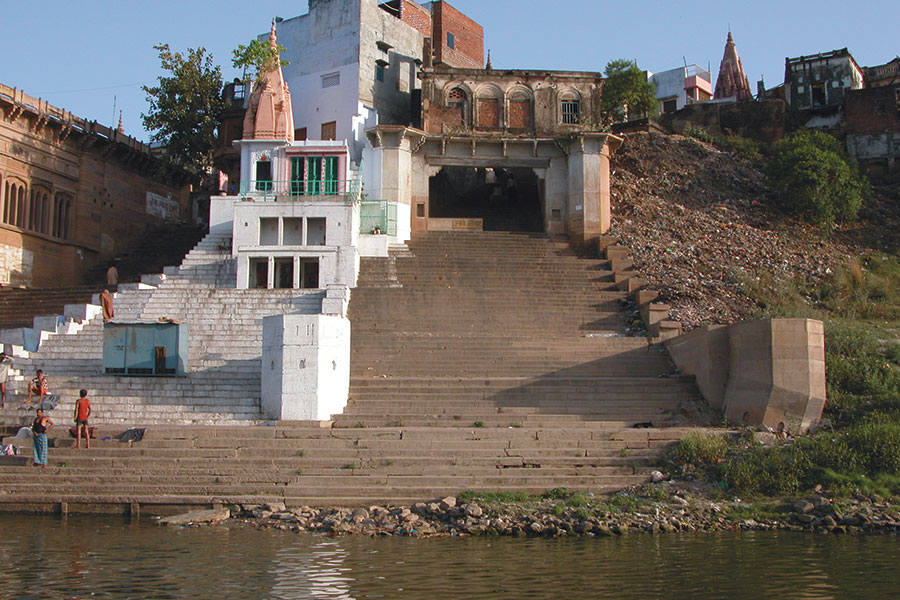
Ganges Water Machine: Designing New India’s Ancient River
Anthony Acciavatti
Applied Research and Design Publishing, $50
The Ganges River originates in the Himalayas and flows across northern India, where it ends in the Ganges River Basin, a highly productive agricultural zone that encompasses one-quarter of India’s current population of more than 1.25 billion people. In addition to the problem of balancing agricultural production and high population density, the Ganges River is also an alluvial plain, radically changing every year due to the summer monsoons. It is the highly dynamic nature of the Ganges and the infrastructure that has been built around it, ranging from the colonial canals to networks of individually drilled wells, that have inspired Anthony Acciavatti’s extensive research collected in Ganges Water Machine. His book draws connections between agricultural zones and urban centers and gives perspective to the possibilities for design research that are as applicable to the growth of “New India” as they are to arid California.
Trained as both an architect and a historian of science, Acciavatti has traveled extensively in the Ganges River Basin for the past decade and has documented its layers of development and speculated about its future. It is this tension between illustrating the past and outlining scenarios for the future that allows Ganges to function as both atlas and almanac, a socio-technological history of the Ganges River Basin and an index of diagrams, photos, and maps that contemplates how its changing.
Acciavatti begins at present-day Gaumukh, one of the primary sources of the Ganges, and descends into the Ganges River Basin while combining text, image, and diagram to describe the interplay of the indigenous and the imperial. Acciavatti compiled more than 25,000 photos during the course of his research, and he uses a sampling of these images to show the passage of time and states of change. Alexander von Humboldt’s concept of the transect, a three-dimensional sectional drawing meant to highlight change in the natural environment, appears throughout the book. These transect drawings reveal the gradient of the river surface and the natural conditions below and beyond the Ganges basin. With the continual use of sectional drawings and photographs throughout the project, Acciavatti complements contemporary documentation with archival images of imperial fantasy related to the Ganges.
These British colonial representations morph into a narrative of the Ganges as a “supersurface,” a river basin that connects to a network of canals extending throughout northwest India. Here, a narrative of control emerges through the exploration of work of Victorian-era engineers such as Sir Proby Cautley and Patrick Flynn. This narrative is paired with design documentation of projects in three major zones of the Ganges River Basin. Each of these zones involved the construction of rajbujas, outlets to villages from the central canal, which were owned by irrigators, not the government. Despite this ability to distribute water through rajbujas, and an ever-expanding canal system off the Ganges, colonial engineers were learning by the mid-1940s that mass starvation could occur should an even greater percentage of the population not gain access to the water of the Ganges.
It was this necessity that drove the development of the tubewell, a steel or plastic pipe that can extend 200 feet below the surface and, with the use of an engine, extract water from the aquifer that flows beneath the Ganges. With the creation of tubewells, the control of water was extended away from the government and into the hands of farmers and millions of others who live near the densely populated Ganges River Basin. The World Bank, the American government, and NGOs became involved in the development of tubewells, which now number more than 3.5 million in the Ganges region. With an extensive description of the development of the tubewell network, Acciavatti briefly speculates on who owns these wells and the possibility of uneven development and the concentration of power in their operation. However, with the amount of rigor and research previously devoted to describing large-scale water projects, both the concepts of atlas and almanac would be greatly enhanced through some mapping of existing tubewells as well as drawing connections to ownership, operation, and power.
Acciavatti ends Ganges with a chapter titled “Changes of State,” which extensively documents the existing conditions of six transects of the supersurface of the Ganges River. With its invocation of change, this final chapter most aspires to function as almanac, an illustration of the dynamic nature of the Ganges and how it impacts the population around it. While attractive as abstract line drawings, the representation in this section is difficult to read and even harder to understand in terms of its implications of change. Perhaps this is where the book falls short as an almanac. While Acciavatti’s work rigorously weaves documentation of present conditions with a history of the design and development of the Ganges supersurface, the dynamic nature of the river and the power of those who control it are not as apparent.
For readers familiar with the development of water infrastructure that led to the growth of the West, and 20th-century Los Angeles in particular, greater probing into the nature of infrastructure, water, and power might seem merited. The California Water Wars, which began with the construction of the Los Angeles aqueduct and the drainage of water from Owens Valley, created a political dynamic between urban growth and the agricultural economy that continues to affect the future of planning and development in California. It is impossible to understand the creation of the Los Angeles aqueduct as its own kind of water machine without studying the political forces that both supported and fought its development.
Despite this, Ganges Water Machine offers us a viewpoint and suggests a methodology for documenting and understanding water infrastructure. As our own approach to the built environment will inevitably need to adapt due to the contingencies of climate change, this viewpoint is a valuable starting point for conceiving new processes for design in response to constant states of change.